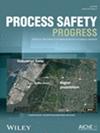Evaporation of anhydrous ammonia from small concrete coupons and implications regarding evaporation from a large accidental spill on concrete
IF 1
4区 工程技术
Q4 ENGINEERING, CHEMICAL
引用次数: 0
Abstract
Anhydrous ammonia is transported via ship, rail, and road everyday in the United States as a refrigerated liquid at ambient pressure. As a result, unintential release of a large amount of anhydrous ammonia could result from an accident during transportation. The aim of this paper is to provide a better understanding of the evaporation of anhydrous ammonia from porous media. In our investigation, laboratory-scale concrete coupons were used as a surrogate for a larger concrete pad that could be present in an event involving an unintentional release of liquid anhydrous ammonia. Concrete coupons sized 5 cm × 5 cm × 1.9 cm were saturated in liquid anhydrous ammonia, and measurements of the subsequent evaporation from the coupons were made in an environmental chamber. The ambient air temperature within the chamber varied from 5 to 45°C, and the relative humidity varied from 5% to 75%. Mass-difference calculation and Berthelot's reaction were used to determine the average evaporation rate from a concrete coupon across all trials, which was found to be 6.5 ± 1.9 mg/s. To validate these evaporation rates, the remaining ammonia in the concrete coupon was measured for each trial. We found that the time-integrated calculated evaporation rates correlated well with the total mass of ammonia that was lost from the coupons. In addition, it was found that ambient air temperature and relative humidity had little influence on anhydrous ammonia evaporation from the concrete coupons.无水氨在小混凝土板上的蒸发及其对混凝土大意外泄漏蒸发的影响
在美国,无水氨每天都以常温下的冷冻液体的形式通过船舶、铁路和公路运输。因此,在运输过程中意外释放大量无水氨可能会导致事故。本文的目的是为了更好地理解无水氨从多孔介质中的蒸发。在我们的调查中,实验室规模的混凝土券被用作更大的混凝土垫的替代品,可能存在于涉及无意中释放液体无水氨的事件中。尺寸为5 cm × 5 cm × 1.9 cm的混凝土薄片在液体无水氨中饱和,并在环境室中测量薄片随后的蒸发。试验室内环境温度为5 ~ 45℃,相对湿度为5% ~ 75%。质量差计算和贝特洛反应用于确定所有试验中混凝土片的平均蒸发速率,发现其为6.5±1.9 mg/s。为了验证这些蒸发速率,在每次试验中测量混凝土中剩余的氨。我们发现,时间积分计算的蒸发速率与从优惠券中损失的氨总质量具有良好的相关性。此外,环境空气温度和相对湿度对混凝土板无水氨蒸发影响不大。
本文章由计算机程序翻译,如有差异,请以英文原文为准。
求助全文
约1分钟内获得全文
求助全文
来源期刊

Process Safety Progress
工程技术-工程:化工
CiteScore
2.20
自引率
10.00%
发文量
99
审稿时长
6-12 weeks
期刊介绍:
Process Safety Progress covers process safety for engineering professionals. It addresses such topics as incident investigations/case histories, hazardous chemicals management, hazardous leaks prevention, risk assessment, process hazards evaluation, industrial hygiene, fire and explosion analysis, preventive maintenance, vapor cloud dispersion, and regulatory compliance, training, education, and other areas in process safety and loss prevention, including emerging concerns like plant and/or process security. Papers from the annual Loss Prevention Symposium and other AIChE safety conferences are automatically considered for publication, but unsolicited papers, particularly those addressing process safety issues in emerging technologies and industries are encouraged and evaluated equally.
 求助内容:
求助内容: 应助结果提醒方式:
应助结果提醒方式:


